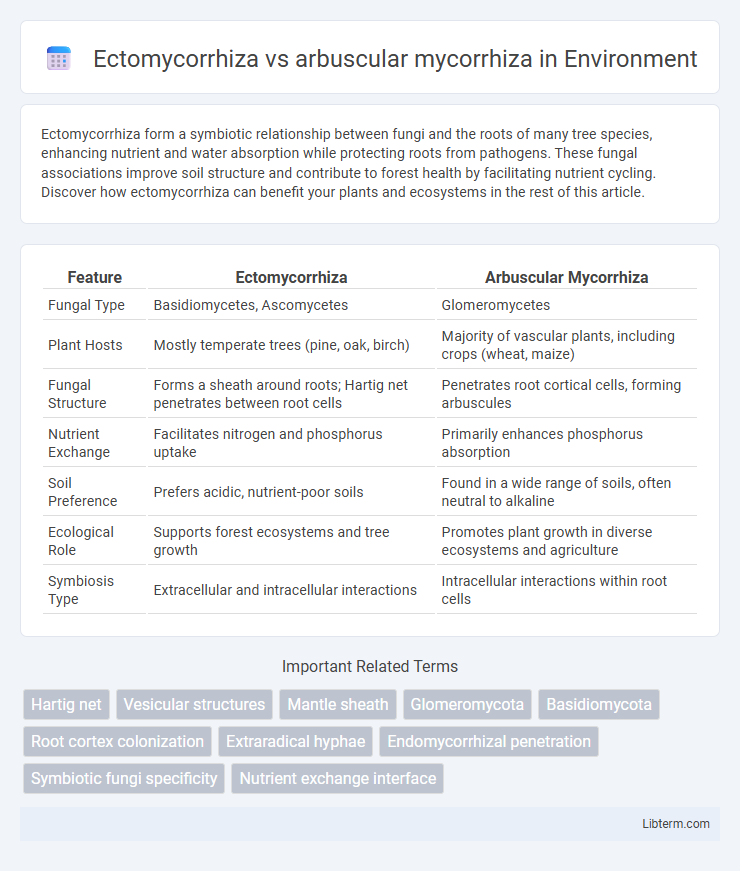Ectomycorrhiza form a symbiotic relationship between fungi and the roots of many tree species, enhancing nutrient and water absorption while protecting roots from pathogens. These fungal associations improve soil structure and contribute to forest health by facilitating nutrient cycling. Discover how ectomycorrhiza can benefit your plants and ecosystems in the rest of this article.
Table of Comparison
| Feature | Ectomycorrhiza | Arbuscular Mycorrhiza |
|---|---|---|
| Fungal Type | Basidiomycetes, Ascomycetes | Glomeromycetes |
| Plant Hosts | Mostly temperate trees (pine, oak, birch) | Majority of vascular plants, including crops (wheat, maize) |
| Fungal Structure | Forms a sheath around roots; Hartig net penetrates between root cells | Penetrates root cortical cells, forming arbuscules |
| Nutrient Exchange | Facilitates nitrogen and phosphorus uptake | Primarily enhances phosphorus absorption |
| Soil Preference | Prefers acidic, nutrient-poor soils | Found in a wide range of soils, often neutral to alkaline |
| Ecological Role | Supports forest ecosystems and tree growth | Promotes plant growth in diverse ecosystems and agriculture |
| Symbiosis Type | Extracellular and intracellular interactions | Intracellular interactions within root cells |
Introduction to Mycorrhizal Associations
Mycorrhizal associations form symbiotic relationships between fungi and plant roots, enhancing nutrient and water uptake. Ectomycorrhizae primarily associate with woody plants, forming a dense sheath around root tips and facilitating nutrient exchange through a Hartig net. Arbuscular mycorrhizae penetrate root cortical cells, creating arbuscules that optimize phosphorus transfer and are widespread among herbaceous plants and many crops.
What Are Ectomycorrhiza and Arbuscular Mycorrhiza?
Ectomycorrhiza and arbuscular mycorrhiza are two major types of mycorrhizal fungi that form symbiotic relationships with plant roots, enhancing nutrient uptake. Ectomycorrhiza typically associate with woody plants, forming a sheath around the root tips and penetrating the root cortex's intercellular spaces. Arbuscular mycorrhiza penetrate root cortical cells directly, creating highly branched structures called arbuscules, which facilitate efficient nutrient exchange in a wide range of herbaceous and crop plants.
Fungal Partners: Key Taxonomic Differences
Ectomycorrhizae primarily associate with Basidiomycota and Ascomycota fungi, including genera such as Amanita, Boletus, and Cortinarius. Arbuscular mycorrhizae form symbioses almost exclusively with Glomeromycota fungi, mainly from the Glomus and Rhizophagus genera. These fundamental taxonomic differences reflect their distinct ecological roles and host associations in terrestrial ecosystems.
Host Plant Range and Specificity
Ectomycorrhiza primarily form symbiotic associations with woody plants, including many temperate and boreal tree species such as pines, oaks, and birches, exhibiting high host specificity. Arbuscular mycorrhiza associate with a broad range of herbaceous and crop plants, including grasses, legumes, and many tropical species, reflecting low host specificity and widespread occurrence. The host plant range of ectomycorrhiza is generally limited to specific plant families, whereas arbuscular mycorrhiza colonize over 80% of terrestrial plant species across diverse taxa.
Structural Differences: Root Colonization Patterns
Ectomycorrhiza forms a dense fungal mantle around root tips, creating a Hartig net that penetrates between root cortical cells without entering them, primarily associating with woody plants. In contrast, arbuscular mycorrhiza penetrates root cortical cells directly and forms arbuscules inside these cells, facilitating nutrient exchange, commonly found in herbaceous plants and many crops. These structural differences impact nutrient uptake efficiency, host specificity, and ecological roles in various ecosystems.
Mechanisms of Nutrient Exchange
Ectomycorrhiza form a sheath around plant roots and facilitate nutrient exchange primarily through a Hartig net, allowing efficient transfer of nitrogen and phosphorus between the fungus and host. Arbuscular mycorrhiza penetrate root cortical cells and create arbuscules, specialized structures that maximize surface area for enhanced exchange of phosphorus and other essential nutrients. The distinct cellular interfaces and morphological adaptations in both mycorrhizal types optimize symbiotic nutrient uptake and transfer to support plant growth.
Ecological Roles and Environmental Adaptability
Ectomycorrhiza forms symbiotic relationships primarily with woody plants, enhancing nutrient uptake, especially phosphorus and nitrogen, while improving host resistance to environmental stress such as drought and heavy metal contamination. Arbuscular mycorrhiza, prevalent in over 70% of terrestrial plants, facilitates nutrient exchange through arbuscules within root cortical cells, supporting plant growth in nutrient-poor soils and increasing tolerance to soil salinity and pathogen attacks. Both mycorrhizal types contribute significantly to ecosystem stability by promoting plant diversity and soil health under varying environmental conditions.
Impact on Plant Growth and Stress Tolerance
Ectomycorrhiza forms symbiotic relationships primarily with woody plants, enhancing nutrient uptake, especially phosphorus and nitrogen, which significantly boosts plant growth and improves drought and pathogen resistance. Arbuscular mycorrhiza associates with a broader range of herbaceous plants, increasing phosphorus absorption and promoting tolerance to salinity and heavy metal stress by improving root system architecture and soil structure. Both types of mycorrhizae activate plant defense mechanisms and improve water relations, although ectomycorrhiza tends to offer greater protection against biotic stresses while arbuscular mycorrhiza is more effective in coping with abiotic stresses.
Agricultural and Forestry Applications
Ectomycorrhizae predominantly associate with woody plants and trees, enhancing nutrient uptake, particularly nitrogen and phosphorus, thus improving forest health and productivity. Arbuscular mycorrhizae form symbiotic relationships with a majority of agricultural crops, increasing phosphorus absorption and drought resistance, which boosts crop yields and soil fertility. Both mycorrhizal types play crucial roles in sustainable agriculture and forestry by promoting plant growth, soil structure, and ecosystem resilience.
Future Perspectives in Mycorrhizal Research
Future perspectives in mycorrhizal research emphasize the genomic and molecular differences between ectomycorrhiza and arbuscular mycorrhiza to enhance symbiotic efficiency in diverse ecosystems. Advances in metagenomics and transcriptomics are enabling the identification of key genes involved in nutrient exchange, stress tolerance, and host specificity. Developing synthetic consortia and bioinoculants targeting these distinct mycorrhizal types holds potential for sustainable agriculture and forest ecosystem restoration under climate change scenarios.
Ectomycorrhiza Infographic

 libterm.com
libterm.com